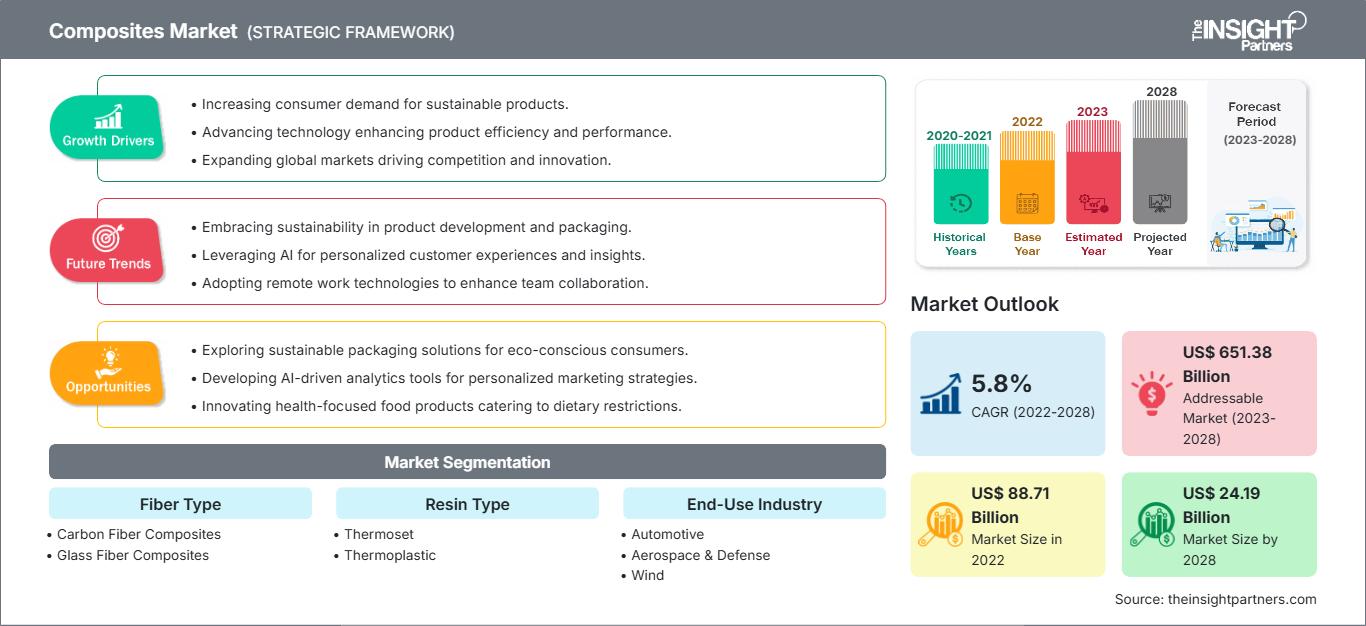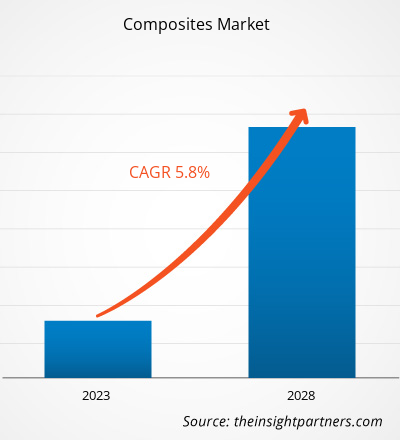Der Markt für Verbundwerkstoffe soll von 88.710,42 Millionen US-Dollar im Jahr 2022 auf 124.185,35 Millionen US-Dollar im Jahr 2028 wachsen; von 2022 bis 2028 wird mit einer durchschnittlichen jährlichen Wachstumsrate von 5,8 % gerechnet.
Verbundwerkstoffe sind im Vergleich zu den meisten Hölzern und Metallen leicht. Aufgrund ihres geringen Gewichts sind sie für den Einsatz in Autos und Flugzeugen wichtig, da weniger Gewicht zu einer besseren Treibstoffeffizienz führt. Flugzeugkonstrukteure legen heutzutage großen Wert auf das Gewicht, da eine Gewichtsreduzierung den Treibstoffbedarf eines Flugzeugs senkt und die erreichbare Geschwindigkeit erhöht. Darüber hinaus sind Verbundwerkstoffe widerstandsfähiger gegenüber Witterungseinflüssen und aggressiven Chemikalien. Sie lassen sich leichter in komplizierte Formen bringen als die meisten anderen Materialien.
Im Jahr 2022 hatte der asiatisch-pazifische Raum den größten Umsatzanteil am globalen Markt für Verbundwerkstoffe. Die Nachfrage nach Verbundwerkstoffen im asiatisch-pazifischen Raum steigt aufgrund der zunehmenden Verwendung von Verbundwerkstoffen in verschiedenen Endverbrauchsbranchen wie der Automobilindustrie, der Windenergiebranche, dem Baugewerbe, der Sportartikelbranche und vielen anderen. Die wachsende Bauindustrie trägt stark zum Wachstum des Verbundwerkstoffmarktes in der Region bei. Der asiatisch-pazifische Raum erlebt eine Urbanisierung, die mit der zunehmenden Errichtung von Wohn- und Gewerbeprojekten einhergeht. Darüber hinaus ist das Pro-Kopf-Einkommen in der Region gestiegen, verbunden mit der Entwicklung erschwinglicher Wohngebäude. Dies hat zu einer raschen Urbanisierung im asiatisch-pazifischen Raum geführt. Die vorteilhafte staatliche Politik im Zusammenhang mit der Entwicklung von Wohnimmobilien in mehreren Ländern der Region hat die Urbanisierung vorangetrieben. Darüber hinaus gehören Länder wie China und Indien zu den fünf Ländern der Welt mit der weltweit größten installierten Windkraft. All diese Faktoren tragen positiv zum Wachstum des Verbundwerkstoffmarktes in der Region bei.
Passen Sie diesen Bericht Ihren Anforderungen an
Sie erhalten kostenlos Anpassungen an jedem Bericht, einschließlich Teilen dieses Berichts oder einer Analyse auf Länderebene, eines Excel-Datenpakets sowie tolle Angebote und Rabatte für Start-ups und Universitäten.
Markt für Verbundwerkstoffe: Strategische Einblicke

-
Holen Sie sich die wichtigsten Markttrends aus diesem Bericht.Dieses KOSTENLOSE Beispiel umfasst Datenanalysen, die von Markttrends bis hin zu Schätzungen und Prognosen reichen.
Auswirkungen der COVID-19-Pandemie auf den Markt für Verbundwerkstoffe
Branchen wie die Automobil-, Luft- und Raumfahrt-, Bau-, Schifffahrts- und Energiebranche haben am meisten zur Nachfrage nach Verbundwerkstoffen beigetragen. Im Jahr 2020 mussten diese Branchen ihre Betriebsabläufe aufgrund von Störungen in der Wertschöpfungskette, die durch die Schließung nationaler und internationaler Grenzen verursacht wurden, drosseln. Der Mangel an Arbeitskräften führte zu einer Verlangsamung der Produktion und des Vertriebs von Verbundwerkstoffen. Störungen in der globalen Lieferkette und die Schließung von Harzproduktionsanlagen führten zu einem starken Anstieg der Preise für Verbundwerkstoffe. Die von verschiedenen Ländern im Jahr 2020 verhängten Lockdowns behinderten die Fähigkeit der Industrie, ihre Lagerbestände aufrechtzuerhalten. Darüber hinaus reduzierten Hygienemaßnahmen und andere COVID-19-Vorsichtsmaßnahmen die Produktionskapazität erheblich, was zu einem Mangel an Verbundwerkstoffbeständen führte. Im Jahr 2021 begann sich der globale Markt jedoch von den Verlusten des Jahres 2020 zu erholen, als Regierungen verschiedener Länder Lockerungen der sozialen Beschränkungen ankündigten. Darüber hinaus trugen steigende Impfraten zu einer Verbesserung der allgemeinen Bedingungen in verschiedenen Ländern bei, was zu einem förderlichen Umfeld für industriellen und kommerziellen Fortschritt führte. Laut dem Weltwirtschaftsforum birgt die COVID-19-Pandemie das Potenzial, Innovationen im Wohndesign hervorzubringen und dürfte neue Möglichkeiten im Bereich der Hausrenovierung eröffnen. Dieser Faktor dürfte im Prognosezeitraum lukrative Wachstumschancen für den Verbundwerkstoffmarkt bieten.
Markteinblicke
Steigende Nachfrage nach Leichtbauwerkstoffen in der Automobil- und Luftfahrtindustrie
Automobilhersteller bevorzugen Leichtbauwerkstoffe für die Herstellung von Autos und gewährleisten gleichzeitig Sicherheit und Leistung. Leichtbauwerkstoffe haben ein hervorragendes Potenzial zur Steigerung der Kraftstoffeffizienz. Eine 10-prozentige Gewichtsreduzierung eines Fahrzeugs kann zu einer Verbesserung des Kraftstoffverbrauchs um 6–8 % führen. Moderne Werkstoffe wie Kohlefaserverbundwerkstoffe haben das Potenzial, das Gewicht von Automobilkomponenten um 50–75 % zu reduzieren. Die Anwendung von Verbundwerkstoffen im Automobilsektor nimmt weiter zu. Kunststoffverbundwerkstoffe verfügen im Vergleich zu Verbundwerkstoffen nicht erneuerbaren Ursprungs über hervorragende akustische und thermische Eigenschaften, was sie ideal für Fahrzeuginnenteile macht. Darüber hinaus eignen sie sich für die Herstellung nichtstruktureller Innenraumkomponenten wie Sitzpolster, Sitzlehnen, Dachhimmel, Innenverkleidungen und Armaturenbrettern. Darüber hinaus bemühen sich Flugzeughersteller, die primären thermoplastischen Strukturen in Geschäfts- und Verkehrsflugzeugen zu vergrößern. Sie waren die ersten Anwender langfaserverstärkter Thermoplaste.
Einblicke in Fasertypen
Basierend auf dem Fasertyp ist der globale Markt für Verbundwerkstoffe in Kohlefaserverbundwerkstoffe, Glasfaserverbundwerkstoffe und andere unterteilt. Der globale Marktanteil des Segments Glasfaserverbundwerkstoffe war im Jahr 2022 der größte. Glasfaserverbundwerkstoffe werden mit verschiedenen Fertigungstechnologien produziert und für ein breites Anwendungsspektrum eingesetzt. Glasfasern weisen mehrere Eigenschaften auf, nämlich hohe Festigkeit, Flexibilität, Haltbarkeit und Beständigkeit gegen chemische Schäden. Es kann in Form von Rovings, geschnittenen Strängen, Garnen, Geweben und Matten vorliegen. Jede Glasfaserart hat unterschiedliche Eigenschaften und wird in Form von Polymerverbundwerkstoffen für verschiedene Anwendungen eingesetzt. Glasfaserverbundwerkstoffe werden aufgrund ihrer günstigen Eigenschaften wie hohem Festigkeits-Gewichts-Verhältnis, guter Dimensionsstabilität, guter Hitze- und Korrosionsbeständigkeit, guten elektrischen Isoliereigenschaften, einfacher Herstellung und relativ niedrigen Kosten für industrielle Anwendungen bevorzugt.
Zu den wichtigsten Akteuren auf dem globalen Markt für Verbundwerkstoffe gehören DuPontde Nemours Inc, Gurit Holding AG, Hexion Inc, Mitsubishi Chemical Holdings Corp, Nippon Electric Glass Co Ltd, Owens Corning, SGL Carbon SE, Teijin Ltd, Solvay SA und Toray Industries Inc. Die Akteure auf dem globalen Markt für Verbundwerkstoffe konzentrieren sich darauf, qualitativ hochwertige Produkte anzubieten, um die Kundennachfrage zu erfüllen. Sie konzentrieren sich auch auf Strategien wie Investitionen in Forschungs- und Entwicklungsaktivitäten und die Einführung neuer Produkte.
Berichts-Spotlights
- Fortschreitende Branchentrends im Verbundwerkstoffmarkt helfen den Akteuren bei der Entwicklung effektiver langfristiger Strategien
- Geschäftswachstumsstrategien in entwickelten und sich entwickelnden Märkten
- Quantitative Analyse des Verbundwerkstoffmarktes von 2020 bis 2028
- Schätzung der weltweiten Nachfrage nach Verbundwerkstoffen
- Porters Fünf-Kräfte-Analyse zur Veranschaulichung der Wirksamkeit von Käufern und Lieferanten in der Branche
- Jüngste Entwicklungen zum Verständnis des wettbewerbsorientierten Marktszenarios
- Markttrends und -aussichten sowie Faktoren, die das Wachstum des Verbundwerkstoffmarktes vorantreiben und hemmen
- Unterstützung im Entscheidungsprozess durch Hervorhebung von Marktstrategien, die das kommerzielle Interesse untermauern und zum Marktwachstum führen
- Die Größe des Verbundwerkstoffmarktes an verschiedenen Knotenpunkten
- Detaillierte Übersicht und Segmentierung des Marktes sowie die Dynamik der Verbundwerkstoffindustrie
- Die Größe des Verbundwerkstoffmarktes in verschiedenen Regionen mit vielversprechenden Wachstumschancen
Verbundwerkstoffe
Regionale Einblicke in den VerbundwerkstoffmarktDie Analysten von The Insight Partners haben die regionalen Trends und Faktoren, die den Verbundwerkstoffmarkt im Prognosezeitraum beeinflussen, ausführlich erläutert. In diesem Abschnitt werden auch die Marktsegmente und die geografische Lage in Nordamerika, Europa, dem asiatisch-pazifischen Raum, dem Nahen Osten und Afrika sowie Süd- und Mittelamerika erörtert.
Umfang des Marktberichts zu Verbundwerkstoffen
| Berichtsattribut | Einzelheiten |
|---|---|
| Marktgröße in 2022 | US$ 88.71 Billion |
| Marktgröße nach 2028 | US$ 24.19 Billion |
| Globale CAGR (2022 - 2028) | 5.8% |
| Historische Daten | 2020-2021 |
| Prognosezeitraum | 2023-2028 |
| Abgedeckte Segmente |
By Fasertyp
|
| Abgedeckte Regionen und Länder |
Nordamerika
|
| Marktführer und wichtige Unternehmensprofile |
|
Dichte der Marktteilnehmer im Verbundwerkstoffbereich: Verständnis ihrer Auswirkungen auf die Geschäftsdynamik
Der Markt für Verbundwerkstoffe wächst rasant. Die steigende Nachfrage der Endverbraucher ist auf Faktoren wie veränderte Verbraucherpräferenzen, technologische Fortschritte und ein stärkeres Bewusstsein für die Produktvorteile zurückzuführen. Mit der steigenden Nachfrage erweitern Unternehmen ihr Angebot, entwickeln Innovationen, um den Bedürfnissen der Verbraucher gerecht zu werden, und nutzen neue Trends, was das Marktwachstum weiter ankurbelt.

- Holen Sie sich die Markt für Verbundwerkstoffe Übersicht der wichtigsten Akteure
Globaler Markt für Verbundwerkstoffe
Basierend auf dem Fasertyp ist der globale Markt für Verbundwerkstoffe in Kohlefaserverbundwerkstoffe, Glasfaserverbundwerkstoffe und andere unterteilt. Basierend auf dem Harztyp ist der globale Markt für Verbundwerkstoffe in Duroplaste und Thermoplaste unterteilt. Das Duroplastsegment ist weiter in Polyester, Vinylester, Epoxid, Polyurethan und andere unterteilt. Das Thermoplastsegment ist weiter in Polypropylen, Polyethylen, Polyvinylchlorid, Polystyrol, Polyethylenterephthalat, Polycarbonat und andere unterteilt. Basierend auf der Endverbrauchsindustrie ist der globale Markt für Verbundwerkstoffe in die Automobil-, Luft- und Raumfahrt- und Verteidigung, Wind, Bau, Marine, Sportartikel und andere.
Firmenprofile
- DuPont de Nemours Inc
- Gurit Holding AG
- Hexion Inc
- Mitsubishi Chemical Holdings Corp
- Nippon Electric Glass Co Ltd
- Owens Corning
- SGL Carbon SE
- Teijin Ltd
- Solvay SA
- Toray Industries Inc.
- Historische Analyse (2 Jahre), Basisjahr, Prognose (7 Jahre) mit CAGR
- PEST- und SWOT-Analyse
- Marktgröße Wert/Volumen – Global, Regional, Land
- Branchen- und Wettbewerbslandschaft
- Excel-Datensatz
Aktuelle Berichte
Erfahrungsberichte
Grund zum Kauf
- Fundierte Entscheidungsfindung
- Marktdynamik verstehen
- Wettbewerbsanalyse
- Kundeneinblicke
- Marktprognosen
- Risikominimierung
- Strategische Planung
- Investitionsbegründung
- Identifizierung neuer Märkte
- Verbesserung von Marketingstrategien
- Steigerung der Betriebseffizienz
- Anpassung an regulatorische Trends






















 Kostenlose Probe anfordern für - Markt für Verbundwerkstoffe
Kostenlose Probe anfordern für - Markt für Verbundwerkstoffe